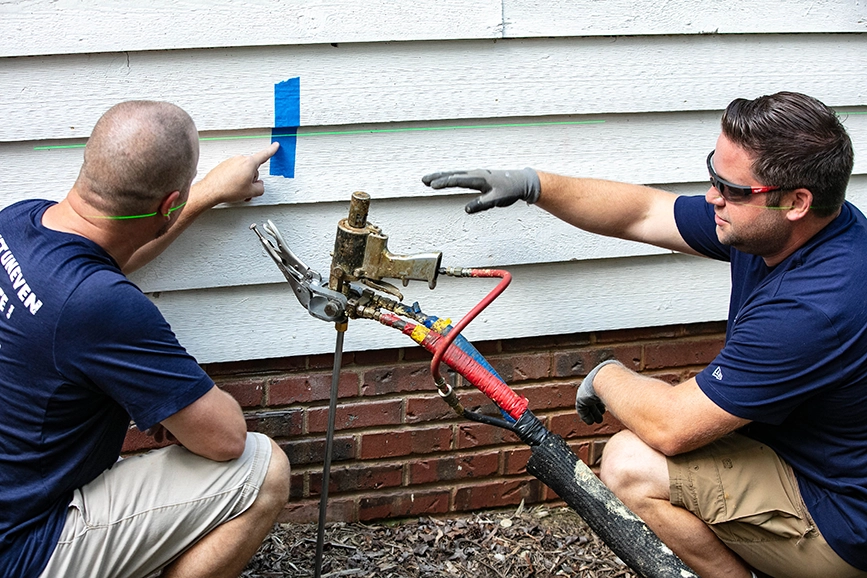Deep injection foundation repair is a specialized method used to stabilize and strengthen weak or compromised soil beneath a building’s foundation. This process involves injecting expanding materials, such as polyurethane foam, deep into the ground to fill voids, compact loose soil, and lift the foundation back to its original position. It’s an effective solution for addressing foundation settlement, cracking, and sinking without the need for extensive excavation.
In this article, we’ll explore what deep injection foundation repair is, how it works, its common uses, and the benefits of choosing this method over traditional repair techniques.
How Deep Injection Foundation Repair Works
The deep injection process involves drilling small holes at strategic points around the foundation. Through these holes, a two-part polyurethane resin is injected deep into the ground, where it expands and hardens. As the material expands, it fills voids in the soil, compacts loose areas, and provides the necessary support to stabilize or lift the foundation.
Key Steps in Deep Injection Foundation Repair:
- Site Assessment: A thorough inspection of the foundation and soil conditions is conducted to determine the extent of settlement and the best locations for injections.
- Drilling Holes: Small holes are drilled into the foundation at targeted points. These holes are spaced according to the specific needs of the structure and the soil conditions beneath it.
- Injecting Polyurethane Foam: A polyurethane foam mixture is injected through the holes into the soil. The foam expands as it reacts, filling voids and compacting the soil. The pressure created by the expansion can also help raise the foundation back to its original level if needed.
- Monitoring the Process: The lifting and stabilization process is closely monitored to ensure the foundation is returned to its correct position without over-lifting.
- Sealing the Holes: Once the injection process is complete, the holes in the foundation are sealed, and the site is cleaned up.
When Is Deep Injection Foundation Repair Needed?
Deep injection foundation repair is commonly used in cases of foundation settlement, where the soil beneath the foundation has shifted, settled, or eroded. This can occur due to a variety of reasons, including:
- Soil Erosion: Water runoff or poor drainage can wash away soil from beneath the foundation, leading to settlement.
- Soil Shrinkage: Expansive soils, such as clay, can shrink during dry conditions, causing the foundation to sink.
- Poor Soil Compaction: If the soil beneath a foundation wasn’t properly compacted during construction, it can settle over time, leading to uneven floors and foundation cracks.
- Voids Beneath the Foundation: Natural or man-made voids beneath the foundation, such as those created by decaying organic material, can cause uneven settlement.
Benefits of Deep Injection Foundation Repair
- Minimal Disruption: Unlike traditional foundation repair methods, which may involve extensive excavation around the foundation, deep injection is a non-invasive solution. The small holes drilled into the foundation are easy to repair, and there’s little to no disruption to landscaping or structures.
- Quick and Efficient: Deep injection is a fast process, often completed in a matter of hours or days, depending on the size of the project. This minimizes downtime for homeowners and businesses.
- Long-Lasting Solution: Polyurethane foam used in the injection process is highly durable and resistant to water, meaning it won’t break down over time. The foam creates a stable and long-lasting foundation support system.
- Cost-Effective: Compared to other foundation repair methods that involve excavation, underpinning, or installing piers, deep injection is typically more affordable. It also saves on labor and material costs.
- Environmentally Friendly: Since the process uses fewer materials and doesn’t require extensive digging or concrete, it has a lower environmental impact than traditional foundation repair methods.
- Versatility: Deep injection can be used in a variety of soil types and conditions, making it suitable for residential, commercial, and industrial projects.
Deep Injection vs. Other Foundation Repair Methods
There are several foundation repair methods available, each with its advantages and drawbacks. Below is a comparison of deep injection with other common techniques:
- Piering: Piering involves driving steel or concrete piers deep into the ground to stabilize the foundation. While effective for severe settlement, piering is more invasive and labor-intensive than deep injection. It also typically costs more.
- Underpinning: Underpinning is a traditional method that involves strengthening the foundation by extending it deeper into more stable soil. This process can require significant excavation and is often more expensive and time-consuming than deep injection.
- Mudjacking: Similar to polyurethane foam injection, mudjacking involves pumping a mixture of concrete and other materials beneath a sinking foundation. However, mudjacking materials are heavier, which can lead to additional settlement in the future. Polyurethane foam, by contrast, is lightweight and provides longer-lasting results.
Conclusion
Deep injection foundation repair offers a fast, cost-effective, and minimally invasive solution for stabilizing foundations and correcting settlement issues. By using expanding polyurethane foam, this method fills voids, compacts soil, and lifts the foundation back to its proper level, all without the need for disruptive excavation.
If you notice signs of foundation settling or cracking, such as uneven floors, sticking doors, or gaps between walls and floors, deep injection may be the right solution to restore your home or building’s structural integrity. Always consult with a foundation repair professional to determine the best course of action for your specific needs.

